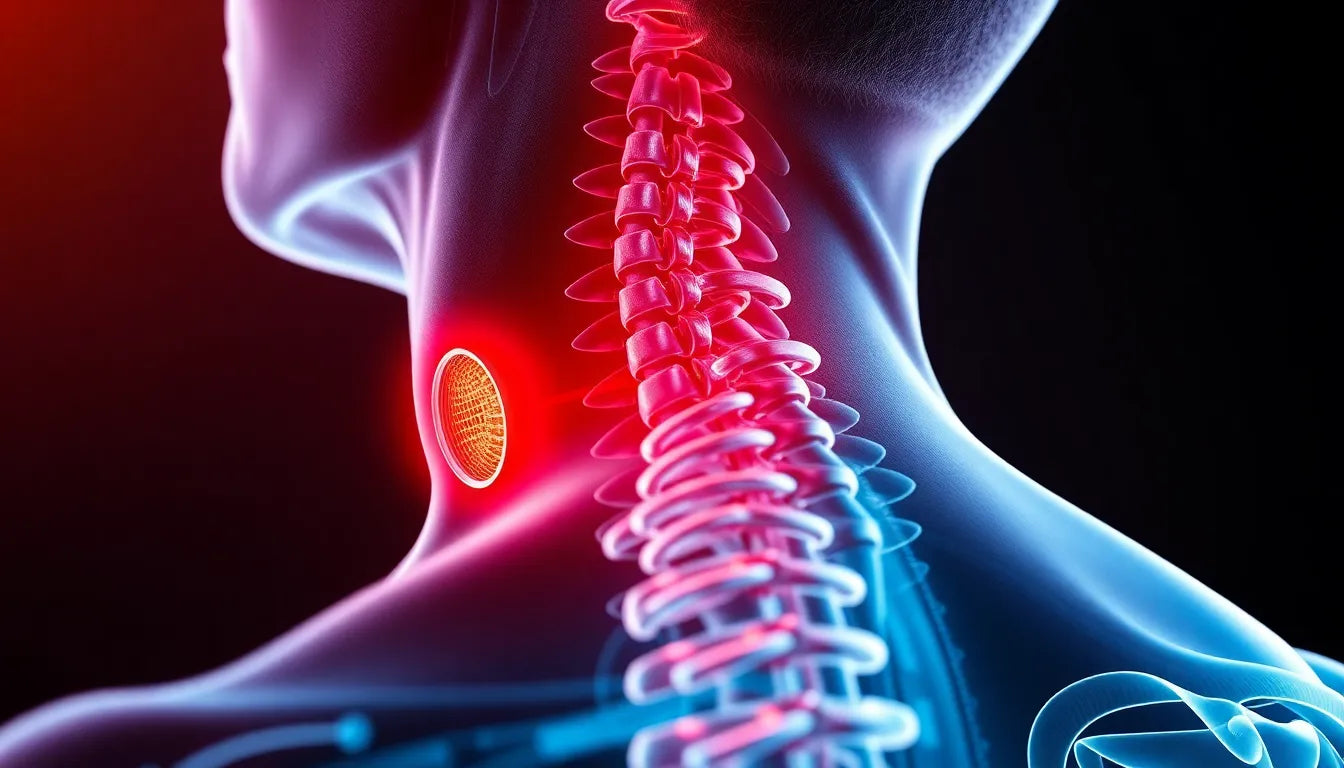A herniated disc is a common spinal condition that can cause significant discomfort and disrupt daily activities. Understanding what a herniated disc is and how it affects the body is crucial for finding effective relief. Essentially, the spine is composed of a series of bones called vertebrae, cushioned by discs that act as shock absorbers. When a disc becomes damaged or slips out of place, it can press on nearby nerves, leading to pain, numbness, or weakness in the affected area.
The prevalence of herniated discs is noteworthy. According to various studies, it's estimated that a significant portion of the adult population will experience a herniated disc at some point in their lives. Common causes include the natural aging process, where discs lose their flexibility and elasticity, as well as injury or strain from heavy lifting or sudden movements. Lifestyle factors, such as prolonged sitting or poor posture, can also contribute to the development of this condition.
The importance of addressing herniated disc pain
Ignoring the symptoms of a herniated disc can lead to more severe complications over time. Pain and discomfort can become chronic, significantly impacting quality of life and potentially leading to further spinal issues. Therefore, it's crucial to address herniated disc pain promptly. Early intervention can prevent further damage and promote a quicker recovery.
The search for relief
Fortunately, there is a wide range of treatments available for managing herniated disc pain. These options vary from non-invasive methods to more advanced surgical interventions, depending on the severity of the condition and the individual's specific needs. The goal of this blog is to provide a comprehensive guide to effective solutions for herniated disc pain, helping you navigate the various treatment paths available.
Whether you're considering conservative treatments like physical therapy and pain management medications or exploring surgical options, understanding the benefits and limitations of each approach is key to making informed decisions. By exploring these options, you can find a treatment plan that aligns with your lifestyle and health goals, ultimately leading to relief and improved well-being.
conservative treatment options for herniated disc
When it comes to managing herniated disc pain, conservative treatment options are often the first line of defense. These non-surgical methods focus on alleviating pain and improving function, allowing many individuals to return to their normal activities without the need for invasive procedures.
physical therapy for herniated discs
Physical therapy plays a crucial role in treating herniated discs. It involves targeted exercises and stretches designed to strengthen the muscles surrounding the spine, enhance flexibility, and promote proper spinal alignment. By following a customized physical therapy program, patients can often experience significant improvement in their symptoms.
Success stories abound, with many patients reporting relief within weeks of starting therapy. A typical recovery timeline can vary, but consistent participation in physical therapy sessions is key to achieving optimal results. Here is a table of common exercises used in physical therapy for herniated discs:
| Exercise | Purpose |
|---|---|
| Pelvic Tilts | Strengthen lower back muscles |
| Knee-to-Chest Stretch | Relieve lower back tension |
| Hamstring Stretch | Improve flexibility |
| Cat-Cow Stretch | Enhance spinal mobility |
pain management medications
For many individuals, medications are an essential component of managing herniated disc pain. Common medications include nonsteroidal anti-inflammatory drugs (NSAIDs), muscle relaxants, and pain relievers. These medications can help reduce inflammation and alleviate pain, making daily activities more manageable. However, it's important to consult with a healthcare professional to understand potential side effects and ensure proper usage.
hot and cold therapy
Alternating hot and cold therapy is another effective method for managing herniated disc pain. Cold therapy can help reduce inflammation and numb the affected area, while hot therapy promotes blood flow and relaxes muscles. For safe application, it's recommended to apply cold packs for 15-20 minutes and follow with a warm compress. This alternating approach can provide significant pain relief and improve mobility.
injections for herniated disc relief
In some cases, injections may be recommended to provide more targeted relief. Epidural steroid injections (ESIs) are commonly used, with success rates ranging from 76% to 88%. Selective nerve root blocks (SNRBs) offer another option, boasting success rates of around 75% for up to one year. Additionally, A2M injections utilize the body's own anti-inflammatory proteins to reduce pain and inflammation. These injections can offer substantial relief, although the duration of their effectiveness may vary.
spinal decompression therapy
Spinal decompression is a non-surgical therapy that gently stretches the spine, allowing herniated discs to return to their proper position. This therapy is particularly effective for many patients, who report feeling relaxed and experiencing significant pain relief. By alleviating pressure on the spine, spinal decompression can enhance overall function and well-being.
lifestyle modifications for recovery
Incorporating lifestyle modifications is a vital aspect of recovering from a herniated disc. Activity modification and rest are essential for allowing the spine to heal. Additionally, making ergonomic adjustments at home and work can support recovery and prevent further injury. Simple changes, such as using an ergonomic chair or adjusting computer screen height, can make a significant difference in promoting spinal health.
By exploring these conservative treatment options, individuals with herniated disc pain can find effective relief and improve their quality of life. In the next section, we'll delve into surgical interventions for those who may require more advanced treatment options.
Additional considerations for herniated disc treatment
While conservative and surgical treatments provide a structured approach to managing herniated disc pain, additional considerations can enhance recovery and prevent recurrence. Patients who have experienced success with various treatments often share their stories, offering hope and insights to others facing similar challenges. For instance, individuals who have undergone physical therapy frequently report significant improvements in their quality of life, citing increased mobility and reduced pain as key outcomes.
Recovery timelines
Understanding recovery timelines is crucial for setting realistic expectations. The duration of recovery varies depending on the treatment method and individual circumstances. For conservative treatments such as physical therapy, patients typically see improvements within a few weeks to a few months. Surgical interventions may require longer recovery periods, often ranging from several weeks to a few months, depending on the specific procedure and the patient's overall health.
- Physical therapy: 6-12 weeks for noticeable improvement
- Pain management medications: Immediate relief, ongoing usage as needed
- Hot and cold therapy: Immediate relief, can be used daily
- Injections: Relief within days, lasting several months
- Spinal decompression: Relief within a few sessions, ongoing benefits
- Microdiskectomy/Discectomy: 4-6 weeks for initial recovery
- Disc replacement surgery: 6-12 weeks for initial recovery
- Spinal fusion: 3-6 months for full recovery
Preventive measures
Preventive measures play a vital role in reducing the risk of future herniated disc occurrences. Maintaining a healthy weight and engaging in regular exercise can significantly alleviate stress on the spine. Incorporating ergonomic aids in daily life, such as ergonomic chairs and adjustable desks, supports proper posture and reduces strain on the back. Additionally, practicing good lifting techniques and avoiding prolonged sitting can help maintain spinal health.
Frequently asked questions
What are the first signs of a herniated disc?
The first signs of a herniated disc often include localized back pain, numbness, or tingling in the limbs, and muscle weakness. If you experience these symptoms, it is advisable to seek medical advice for a proper diagnosis and treatment plan.
How long does it typically take to recover from a herniated disc?
Recovery times vary based on the treatment approach. Conservative treatments like physical therapy may lead to improvements within a few weeks to months, while surgical interventions can require several weeks to months for full recovery.
Can lifestyle changes really make a difference in managing herniated disc pain?
Yes, lifestyle changes can significantly impact herniated disc management. Regular exercise, maintaining a healthy weight, and using ergonomic aids can complement medical treatments and help prevent recurrence.
When should someone consider surgery for a herniated disc?
Surgery is typically considered when conservative treatments fail to alleviate symptoms or if there is significant nerve compression causing severe pain or functional impairment. A healthcare professional can help determine the appropriate course of action.
Are there any long-term risks associated with herniated disc treatments?
While most treatments are safe, there are potential risks associated with each option. For instance, medications may have side effects, and surgical procedures carry risks of complications. Discussing these with a healthcare provider can help mitigate risks and ensure a safe treatment plan.
Sources
- Mayo Clinic Staff. (2021). "Herniated Disk." Mayo Clinic.
- Cleveland Clinic Staff. (2022). "Herniated Disk: Overview." Cleveland Clinic.
- Sciatica.com. (2023). "Herniated Disc Treatment Options."
- Northeast Spine and Sports. (2023). "Herniated Disc Treatment."
- MidAmerica Orthopaedics. (2023). "Herniated Disc Surgical Options."


















